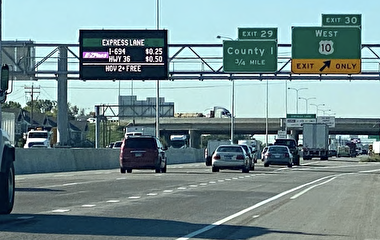While fully automated vehicles may be the future of transportation, key pieces of the underlying technology are available to consumers on some new vehicles today. One example is adaptive cruise control (ACC), which adjusts a vehicle’s speed to follow the vehicle ahead of it at a desired distance. This partial automation creates opportunities to improve safety and manage traffic flow, but also raises concerns about system resiliency and cyberattacks.
In a recent study, U of M researchers developed an analytical method that would allow vehicles using cooperative ACC to detect erroneous or malicious data and then react by changing the use of the system. (Cars using cooperative ACC, or CACC, follow each other closely and brake and accelerate cooperatively and synchronously.) The project was led by Michael Levin, assistant professor in the Department of Civil, Environmental, and Geo- Engineering, and Rajesh Rajamani, professor in the Department of Mechanical Engineering.
“Malicious actors could hack vehicle communications to incorrectly report position, speed, or accelerations to cause a collision,” Rajamani says. “Sensor faults can also be a serious source of problems for many intelligent transportation systems. To prevent these problems, system resiliency is essential.”
The researchers developed an estimation algorithm that can detect cyberattacks on a CACC system while monitoring the health of the radar sensor. Their simulation results show that the estimation system was able to detect either a cyberattack or a fault in the radar. “By comparing the two data sources, the system achieves resiliency under cyberattacks,” Rajamani says.
The researchers looked at two other aspects of vehicle connectivity that could provide near-term impacts. First, they studied whether position reports from connected vehicles could provide sufficient data for traffic management and operations.
“We found that even if the market penetration of connected vehicles is limited, it’s possible to estimate traffic flows and densities for specific spaces and times,” Levin says. “This means the basic messages from CACC communications could supplement or potentially replace other traffic data-gathering tools, such as loop detectors and video detectors.” Loop detectors need to be embedded in pavement and video detectors should be installed on high buildings—and both are difficult to maintain.
Last, the researchers looked at traffic flow during the transition period when automated vehicles (AVs) using CACC will share the road with human-driven cars. Simulations of Round Rock, Texas, show that if a set of freeway lanes are converted to AV-only, those “platooning” lanes would have much higher speeds and reliability. When enough AVs use the platooning lanes, traffic congestion would decrease in the freeway corridor.
However, overall travel times would increase for both AVs and drivers, and congestion would rise in the city overall. “Because drivers have fewer available lanes on freeways, they switch to arterial roads,” Levin explains. “AVs also increase their use of arterials to connect to their uncongested platooning lanes.” (Read more about this research in the August 2018 CTS Catalyst.)
The project was one of five that received seed funding from CTS last year. CTS seed funding, awarded biennially, aims to help CTS Scholars develop expertise in emerging areas and foster strategic relationships that position them for future funding opportunities.



